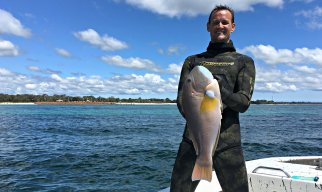With this week marking the lifting of the west coast demersal closure, the Department of Primary Industries and Regional Development (DPIRD) have released the latest stock assessment science.

We hope those of you who have already headed out to try and bag yourself a dhuie, pinkie or a baldie have managed to get amongst ‘em.
It’s been 10 years since wholesale rule changes were brought in to recover some of these species after all the research showed the stocks were in strife. Since those changes were implemented, recfishers have played our part – a big part – in sticking to the rules designed to achieve a 50 per cent reduction in the catch from 2005/6 levels and recover these slow-growing species’ stocks within a 20-year timeframe.
Now we are at the recovery plan’s mid-way point, the Department have released a west coast demersal update based on their latest research.
READ DPIRD’S WEST COAST DEMERSAL RECOVERY RESEARCH SUMMARY HERE
Good stewardship pays off

It will come as no surprise to many of us who target bottom fish in the metro and the South West that there are some good signs with many more, smaller dhuies being seen in the last few years. This is certainly grounds for cautious optimism, showing that our good work and stewardship, sticking to bag and size limits, and the annual two-month closure, is paying off.
However, we’re not out of the woods yet with the research showing limited evidence of recovery for demersal scalefish stocks in the Mid-West and Kalbarri areas. In addition, there appears to be few older dhuies and pinkies in the Department’s samples from across the whole bioregion (Kalbarri down to Augusta).
This shows there is still away to go and, while the recovery is progressing well, we need to keep doing what we’re doing to ensure the recovery stays on track.
That means doing everything we can to ensure released fish go back healthily. Barotrauma can impact on these species significantly, with the research summary showing that ‘post-release mortality’ – fish dying after being released – is potentially having an impact on the recovery.
So, it’s imperative to handle the fish carefully and use release weights to give them the best chance of going back well, if returning them.
It also highlights why catch and release fishing for demersals is not OK and once you’ve hit your bag limit, it’s important to move on and target other species like pelagics and squid.

FIND OUT MORE ABOUT WHY CATCH AND RELEASE FISHING FOR DEMERSALS IS NOT OK HERE
Taking stock
Clearly, the Department needs to keep gathering scientific evidence to monitor the recovery’s progress. And this is also where we can all play a big part by donating some of our demersal frames to the Department’s Send Us Your Skeletons sampling program.
The more samples the scientists get – the clearer and more robust picture they can build of the stocks’ health. So do the right thing by the fish and help the Department collect more samples by donating some of your frames to science (you can keep the wings and the cheeks – they just need the heads and the guts intact).
CLICK HERE TO FIND OUT MORE ABOUT THE DEPARTMENT’S SEND US YOUR SKELETONS PROGRAM
So, we hope you get to bag a demersal or two for Christmas – but let’s continue to work together to ensure the recovery continues to progress and that there will be plenty of these fantastic fish to go at for us and for future generations of West Aussie fishers.